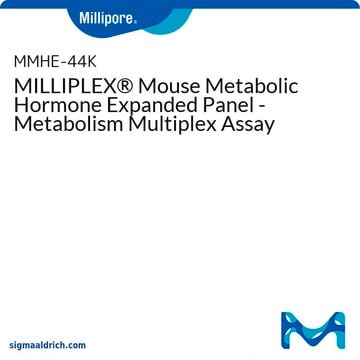The use of deionized water is crucial for immunoassays in general. In this case, lower signal for the standards and controls was observed when non-deionized water was used. Despite the buffers containing EDTA, it seems that they may have been overloaded with ions and thus not able to chelate all of them.
MPTMAG-49K
MILLIPLEX® Mouse Pituitary Magnetic Bead Panel - Endocrine Multiplex Assay
The analytes available for this multiplex kit are: ACTH, BDNF, FSH, GH, Prolactin, TSH, LH.
About This Item
Prodotti consigliati
Livello qualitativo
Reattività contro le specie
mouse
Produttore/marchio commerciale
Milliplex®
assay range
accuracy: 96-101%
standard curve range: 12.2-50,000 pg/mL
(TSH)
standard curve range: 122-500,000 pg/mL
(Prolactin)
standard curve range: 2.4-10,000 pg/mL
(ACTH)
standard curve range: 2.4-10,000 pg/mL
(BDNF)
standard curve range: 24.4-100,000 pg/mL
(FSH)
standard curve range: 4.9-20,000 pg/mL
(GH)
standard curve range: 4.9-20,000 pg/mL
(LH)
inter-assay cv: <20%
intra-assay cv: <15%
tecniche
multiplexing: suitable
Metodo di rivelazione
fluorometric (Luminex xMAP)
Condizioni di spedizione
wet ice
Descrizione generale
MILLIPLEX® Mouse Pituitary Panel is a 7-plex kit to be used for the simultaneous quantification of any or all of the following analytes in mouse serum, plasma, and tissue culture samples: ACTH, BDNF, FSH, GH, Prolactin, TSH and LH. This kit uses a 96-well format, contains a lyophilized standard cocktail, two internal assay quality controls and can measure up to 38 samples in duplicate.
The Luminex® xMAP® platform uses a magnetic bead immunoassay format for ideal speed and sensitivity to quantitate multiple analytes simultaneously, dramatically improving productivity while conserving valuable sample volume.
Panel Type: Endocrine
Applicazioni
- Analytes: ACTH, BDNF, FSH, GH, LH, Prolactin, TSH
- Recommended Sample Type: Mouse serum, plasma, cell/tissue culture supernatants or lysates
- Recommended Sample Dilution: 10 μL per well of undiluted serum or plasma; cell/tissue culture samples may require dilution in an appropriate control medium.
- Assay Run Time: For greater sensitivity an overnight incubation is recommended, (16-18 hours) at 2-8°C. Alternatively, incubate for 2 hours at room temperature (20-25°C).
- Research Category: Endocrine
- Research Subcategory: Metabolism
Caratteristiche e vantaggi
Altre note
Note legali
Avvertenze
Danger
Indicazioni di pericolo
Classi di pericolo
Acute Tox. 3 Dermal - Acute Tox. 4 Inhalation - Acute Tox. 4 Oral - Aquatic Chronic 2 - Eye Irrit. 2 - Skin Irrit. 2 - Skin Sens. 1 - STOT SE 3
Organi bersaglio
Respiratory system
Codice della classe di stoccaggio
6.1C - Combustible acute toxic Cat.3 / toxic compounds or compounds which causing chronic effects
Certificati d'analisi (COA)
Cerca il Certificati d'analisi (COA) digitando il numero di lotto/batch corrispondente. I numeri di lotto o di batch sono stampati sull'etichetta dei prodotti dopo la parola ‘Lotto’ o ‘Batch’.
Possiedi già questo prodotto?
I documenti relativi ai prodotti acquistati recentemente sono disponibili nell’Archivio dei documenti.
Contenuto correlato
Uncover tips and tricks to multiplexing in this guide from the experts. Learn how you can enhance the power of your research with MILLIPLEX® multiplexing, including industry guidance for immunoassays, multiplexing tips, one-day MILLIPLEX® multiplex assays for limited lab time, and more.
Multiplex toxicity assays enable researchers to simultaneously measure multiple toxicity biomarkers of various organs to gain a better understanding of toxicity. Explore how MILLIPLEX® multiplex toxicity assays are advancing research on liver injury, kidney toxicity, genotoxicity, and more.
Multiplex immunoassays, such as MILLIPLEX® multiplex metabolic assays, are critical in metabolic syndrome research because they provide a full picture of the different conditions related to it, like diabetes and obesity, as well as save time and sample volume.
-
Was this a case of troubleshooting low MFIs across the standards and controls, with controls falling out of range due to the use of sterile non-deionized water to hydrate the standards and controls?
1 risposta-
Utile?
-
-
In Milliplex Analyst, the concentrations are reported in two columns. One is labeled pg/ml(i) and one is labeled pg/ml. What is the difference between these values?
1 risposta-
The pg/ml values represent individual results and are not adjusted for the dilution factor. Additionally, the pg/ml values are the average results of the replicates, and if a dilution factor is present, this value will be multiplied by the dilution factor.
Utile?
-
Filtri attivi
Il team dei nostri ricercatori vanta grande esperienza in tutte le aree della ricerca quali Life Science, scienza dei materiali, sintesi chimica, cromatografia, discipline analitiche, ecc..
Contatta l'Assistenza Tecnica.









